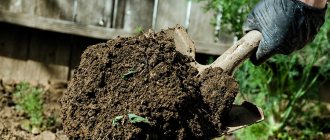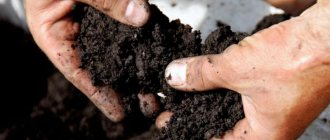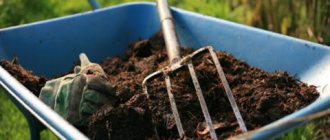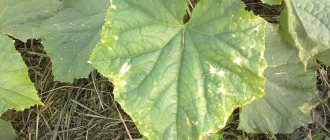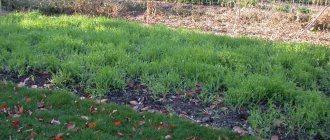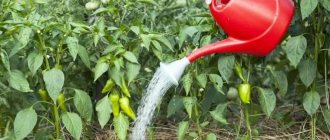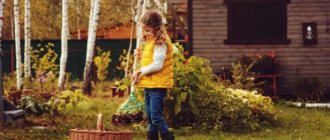Most gardeners have been thinking about what fertilizers to apply in the fall since the summer. This is easily explained, because the future harvest will depend on how the soil is prepared. You need to know what fertilizers, and most importantly, when and how to apply them during autumn digging. Many factors should be taken into account when choosing fertilizers, because an excess of nutrients can be no less harmful than their deficiency. The main task of gardeners is to help the soil become as saturated with nutrients as possible by the beginning of the planting season. Let's look at the technology for applying fertilizer.
Why is autumn digging of the soil necessary?
Fertilizing in the spring is necessary to saturate the plants, and fertilizing in the fall is necessary to saturate the soil. Before cold weather, fertilizer is applied so that the soil can restore its fertile functions wasted over the past season. Otherwise, the land will be depleted, and one can only dream of a good harvest. When do you apply fertilizers for autumn digging? It is best to do this in mid-September; the process lasts until mid-October. The soil of the garden plot is dug up, fertilizers are mixed with the soil in order to dissolve in it before spring.
What fertilizers should I apply in the fall? Overwintering plants that need potassium and phosphorus in winter remain on the site. You should not add a lot of nitrogen fertilizers; half the norm for applying mineral fertilizers is enough. Phosphorus supplements applied during digging in the fall stimulate root growth and increase the resistance of perennial plants to frost. By scattering organic fertilizers in the fall, you can be sure that the soil will have time to absorb all the necessary elements to replenish fertility.
When to Apply Fall Fertilizers
It is difficult to give exact dates: they depend on the climate in a particular region, the rules of harvesting and plowing the soil. As a rule, work takes place in the second half of autumn, but it must be completed before the onset of frost. Otherwise, the plants will not be able to take advantage of the nutrients.
Many gardeners feed plants with mineral preparations in September, before the leaves turn yellow. This applies to fruit trees and shrubs. Organics are added later, in October.
How to fertilize
Methods for applying fertilizers in the fall:
- Differential application of fertilizers allows you to fertilize certain areas before plowing the soil. After harvesting, fertilizers are spread evenly over the ground. Then they dig it up.
- Fertilizers are applied to the holes when planting trees before winter, or when replanting them. In this case, the planting hole is made deeper so that all the roots fit well. Fertilizers are mixed with soil, this mixture is poured into the hole. You need to pour soil on top of the fertilized mixture to prevent the root system from coming into contact with the fertilizer.
Clay and loam love ash
If the question arises of how and how to fertilize the garden in the fall, potassium-rich ash will always come to the rescue. But before you use it, you need to take into account important gardening tips.
Apply only to heavy soil or those with a high clay content.
Calculate the amount of ash per 1 square meter using 2 cups or a half-liter jar.
Start using it in September-October, when the soil is still soft and pliable and has not formed into lumps or large lumps.
Ash is a fertilizer that cooled soil loves. In spring, the mineral is practically not used. With the help of ash, many pests are destroyed. If the place where you plan to plant garlic and onions is well strewn with fine ash, then these crops will look completely different, having gotten rid of their enemies. It is necessary to completely cover the ground with a layer of ash, 1-1.5 centimeters thick.
Organic fertilizers for application in the fall
Organic fertilizers that can be applied to the soil in the fall include:
- Manure.
- Chicken droppings.
- Compost.
- Ash.
- Peat.
- Sawdust.
- Green manure.
You may be interested in: Treatment of grapes in the fall from diseases and pests, feeding grapes
Professional gardeners and gardeners always have these substances in stock, because they all have beneficial properties.
Chicken droppings and manure
Since ancient times, droppings and manure have been considered indispensable when working in a summer cottage; they increase soil fertility. There are certain rules for applying organic matter; you need to follow the timing of fertilizer application; remember that fresh manure cannot be applied to plants; the roots of the seedling may be damaged.
But in the fall you can replenish the soil with fresh manure. After spreading over the area, you must immediately dig up the area. The depth should be from 10 to 18 centimeters. The lighter the soil, the deeper they dig. Fertilizers should not be buried deeper than 18 centimeters; it will be difficult for the plant to obtain nutrients. Perennial vegetables, sweet peppers, cucumbers, late cabbage, and various types of greens respond best to this feeding. Organic fertilizers are applied once over several years. About 300 kg of manure is applied to one hundred square meters of land.
Ash
The ash contains a large number of useful microelements that are necessary for the growth of seedlings. The most effective is considered to be the ash left over from burning weeds, potato tops, and branches. This ash is applied in the fall, the regularity is once every four years. Cabbage, strawberries, potatoes, and shrubs are especially fond of ash fertilizer. About a kilogram of organic matter will be required per square meter of land.
Compost
Compost can be used for autumn feeding, and also as mulch to cover wintering plants. The layer of raw compost for covering should be at least 7 cm. You just need to make sure that the humus does not dry out, otherwise all soil microorganisms will not receive the necessary microorganisms for plant life.
Crops of the nightshade family love compost the most. These are cauliflower, onions, root vegetables. The compost must be aged for at least two years before it is completely ready. Some gardeners do not withstand this period. When using raw compost, remember that it should only be added to the soil in the fall. It is laid out on loose, weed-free soil, using a rake or hoe, and buried 10-13 centimeters into the ground. You will need organic matter (about 4 kg/sq. meter). Legumes and medicinal plants, herbs and root vegetables do not like raw humus.
Peat
Peat in its pure form is not used for digging, but it is the main component of compost. Lowland peat contains very little organic matter, but contains many useful components. High peat contains a lot of organic substances, but it contains few nutrients and has an acidic reaction. That is why it is irrational to use peat as fertilizer on the site.
Sawdust
Sawdust has no nutritional value for plants. They are added when digging the soil to loosen it and retain liquid. Sawdust turns into humus, loved by soil fungi and worms.
You may be interested in: Treatment of apple trees in the fall against pests and diseases, chemical protection preparations
Green manure
Green manures are plants that are planted to improve the condition of the soil. This is the cheapest soil remediation product that contains the nitrogen needed by plants. At the end of summer, green manure is sown in the beds freed up after harvesting some crops: clover, oats, mustard, legumes, and rye. They are considered the best. When plowing the garden in the fall, green manure is simply embedded in the ground.
Fertilizers for berry crops
The bushes should be fed only after all the berries have been collected. The best time for fertilizers is September.
- Ash. This is the ash after burning grass and leaves. You can fertilize shrubs with ash no more than once every three years. Distribute the ash at the rate of 3 kilograms of fertilizer per square meter.
- Bird droppings. This fertilizer is used at a rate of one to three kilograms per square meter of soil. After application, the soil must be dug up. Another option is to dilute the droppings in water in a ratio of 1:15 and pour the resulting solution onto the soil around the bushes or between the rows.
- Lime flour. This complementary feeding is used to reduce the acidity of the soil. This fertilizer is introduced at the rate of 300-400 grams of fertilizer per square meter of soil.
- Complex mineral fertilizers from any specialized store. They must be used in accordance with the instructions for use and the manufacturer's recommendations.
Mineral fertilizers for application before winter
The soil needs mineral fertilizing in the autumn. In those regions where there are frequent long rains, autumn application of fertilizers with minerals is most important.
The most popular potash fertilizers are:
- potassium sulfate;
- wood ash.
Among the phosphorus fertilizers it is worth highlighting:
- ammonium chloride;
- superphosphate;
- ammonium sulfate.
The application rates of mineral fertilizers depend on the characteristics of agricultural technology and soil fertility. It is necessary to take into account the peculiarities of growing individual plants; on average, up to 120 grams of potassium and phosphorus fertilizers are applied per hectare of land every year. Experienced gardeners recommend using organic matter in combination with mineral fertilizers in the fall. In this case, the dose of minerals is reduced by a third.
The feasibility of using fertilizers
Simultaneously with man's development of agriculture, the process of soil depletion began. Intensive exploitation of crop areas has led to soil depletion and necessitated the use of stimulants to increase productivity.
Compost is an effective organic fertilizer based on plant humus.
There are 2 main reasons for poor harvest:
- A large amount of clay, sand in the soil structure and a lack of organic matter.
- Lack of nutrients necessary for full plant growth.
The first problem is dealt with by humus-forming substances. The second is solved by the use of fertilizers.
All substances whose action is aimed at increasing soil fertility are divided into 2 groups:
- Fast action. Accelerates plant growth. In most cases, these are mineral components - ammonium sulfate, for example.
- Slow acting. The result of use is visible after a certain amount of time. This category includes all organic matter and some fertilizers, such as phosphate rock.
At the end of summer, the second group is mainly used.
One of the most common fertilizers is manure.
Combined fertilizers for autumn
A modern agrotechnical complex offers a large number of ready-made combined fertilizers for digging in the fall.
Humic fertilizers
Humic acids are the basis of humic fertilizers. Acids contain humus. Fertilizing improves the water-physical and agrotechnical indicators of the land and increases productivity. Tulip is applied in the fall, before plowing the area. This soil fertilizer is suitable for feeding the area where fruit and berry plants will grow. You can use the drug Yagodka at the dacha.
Giant and Biohumus
These are granular fertilizers that are obtained by processing humus with Californian earthworms. In all its properties, this humus is similar to the humus of chernozems. Fertilizer is applied to the soil according to the instructions on the package.
Record
Organomineral concentrated fertilizer. The fertilizer is based on sludge (sapropel). To enrich the soil for planting garden strawberries, the Record-3 product is suitable.
Biud
This autumn feeding is based on cow or horse manure, as well as bird droppings. It is enriched with amino acids, soil bacteria, and natural growth stimulants. In a short time, this product can enrich even the most weakened soils.
Pixa
Bioorganic substance, it includes peat, sawdust and microorganisms. It does not need to be applied often; it is enough to fertilize the soil with it once over several years. Pixa Lux and Pixa Premium composts are most suitable for the autumn period. 20 kg of this fertilizer is equal to a ton of manure.
Fertik (Kemira)
Complex soil fertilizer without chlorine. The composition contains all the necessary mineral components. “Kemira Universal” is considered the most effective composition; gardeners use it as top dressing and main fertilizer.
You may be interested in: How to deoxidize the soil in the fall, methods of soil deoxidation
Agrophytaqua-AVA
Complex mixture for autumn feeding. It contains about 50% phosphorus, potassium (15%), 10% calcium, 7% magnesium, useful microelements. Every three years you need to fertilize with this mixture. Diammofoska can serve as a replacement for this fertilizer; these substances are similar in composition.
Uses of mullein
Summer residents and those involved in land work on their plots know what humus to add in the fall and what to leave until spring. Fresh, not yet fermented organic matter is added to the soil for autumn digging after all the weeds have been carefully selected and the soil is completely prepared for frost.
Important! In no case should you overdo it with organic matter, so as not to burn the roots of small shrubs or young trees with a strong concentration.
This autumn thickening is introduced at a rate of up to 8 kilograms per 1 square meter. Many farmers choose to use manure when planting to maintain its value for the soil. It is easily diluted with water, after which the area is simply flooded. If you use mullein in dry form for watering, you can simply scatter it in the right places and then dig it under bushes or trees.
Tuki are artificial autumn fertilizers. They are used on large farms and small plots. It is easy to use such fertilizers for the garden in the fall: there are clear instructions that must be followed very strictly. There are foods that are used frequently and have a huge nutritional base.
Superphosphates or autumn phosphorus fertilizer for the garden are applied only in September or early October. In winter, all substances dissolve well, saturate the land, making it an excellent base for planting. Superphosphate is added according to certain rates, which are indicated on the packaging.
For those who are thinking about how to fertilize the soil in the fall, phosphate rock is an excellent solution. This is crushed rock, which is introduced into poor soils and those black soils that are heavily leached. When applying such fertilizers in the fall, it is better to mix them with manure. This will allow phosphorus to pass into the soil faster. This type of feeding is environmentally friendly and safe.
We invite you to familiarize yourself with Going into the shade: Shade-tolerant plants for the garden
Urea is one of the soil's nitrogen helpers. Farmers know this fertilizer in early autumn by its common name - carbide. If the soil is heavy, urea is well retained throughout the winter and combines well with nitrogen.
Autumn feeding of the garden and vegetable garden is also carried out with potassium sulfate. It is well suited for feeding the following crops:
- gooseberry;
- strawberry;
- raspberries;
- strawberries;
- currant.
Those who don’t know how to enrich their gardens and gardens in the fall, feel free to use potassium. It helps plants survive the harshest winters and nourishes the roots well.
Calcium chloride is used on soil that is intended for planting capricious, sickly and weak crops. I am interested in what is the best way to fertilize depleted soil by digging it up in the fall - calcium will help the soil to fully recover.
If September and October are still warm, then the question of how to fertilize the processed soil in early autumn does not arise. At this time, you can grow flowers and herbs. If you plant mustard during this period, it will fill the soil with nitrogen, which will be well preserved during the winter months.
Mustard is also a powerful weed killer that attacks vegetable gardens and orchards on warm and humid days. It prevents weeds from growing and producing seeds. By sowing mustard in the first half of October, gardeners know that the soil will be clean in the spring.
When choosing what fertilizers to apply to the soil in the fall, farmers do not like to resort to planting green manure. There is a simple explanation for this: this rare type of fertilizing is not very common, therefore, many people do not know how to plant and what exactly to plant. The best green manures are clover, peas, alfalfa, oats, rye and lupine.
Autumn feeding of fruit trees and shrubs
Autumn feeding of fruit trees requires individual selection of fertilizers. We present the most popular types of fruit crops and fertilizers suitable for them.
Apple tree
Fertilizing apple trees with mineral fertilizers is carried out in the fall. Young apple tree seedlings require periodic feeding. Fertilizers are applied to the tree trunk circles. During the fruiting period, additional fertilizing is applied between the rows. If the soil is too depleted, it is necessary to feed the soil with organic matter. You will need 500 g of bird droppings per hectare of soil.
Depending on the condition of the soil, phosphorus and potassium fertilizers are applied. To fertilize old trees and shrubs you need to take 13 g/sq.m. m, for young plantings - 9 g/sq. m superphosphate. Potassium sulfate is added in amounts of 27 or 13 grams, respectively.
Strawberry (garden strawberry)
Fertilizers are not applied to the plants in the first few years. For 3-4 years, potassium sulfate and superphosphate should be added as fertilizer for strawberries. In the fall, apply per 1 sq. meter 15 g of potassium sulfate and 25 g of superphosphate.
Gooseberries and currants
After planting the bush, you can apply only nitrogen fertilizers for the first few years. In the third year, in the fall, 5 g of organic matter, 40 g of potassium sulfate, and 40 g of superphosphate are added under the bush. When growing crops on sandy loam soils, fertilizers are applied every year.
Plum
What fertilizers are applied in the fall for fruit trees? The main fertilizers are applied during planting, so the crop first needs feeding after several years. With average soil fertility, you will need 20 g of calcium sulfate, 13 g of superphosphate, 5 kg of organic matter.
Nitrogen
Many summer residents will be surprised: nitrogen fertilizers in the fall? This is wrong! After all, everyone knows that they are easily washed out of the soil with rain and melt water, so they are added only in the spring. In most cases this is true. But among the nitrogen ones, there are those that are fixed in the soil for a long time, even despite the abundance of precipitation. And plants also need nitrogen in the fall! In very small doses, but it is needed. For example, roots, which even in winter show activity, albeit small.
Ammonium nitrate
It contains about 35% nitrogen. The fertilizer works great even in frozen soil, so it can and should be applied in the fall.
How to use. Scatter over the area and cover with a rake.
Peculiarities. Do not mix with urea, calcium nitrate, superphosphate, potassium sulfate, lime, dolomite flour, chalk, potassium carbonate. But especially with organic matter: peat, straw and sawdust - these mixtures can spontaneously ignite and even explode! This interaction also releases toxic nitrogen oxides (5).
And ammonium nitrate should not be used on acidic soils - it will acidify them even more. But for neutral and alkaline areas it is ideal.
Ammonium sulfate (ammonium sulfate)
It contains less nitrogen, only 20%, but it does contain sulfur, the benefits of which have already been mentioned above.
How to use. Scatter over the area and cover with a rake. Or dig it up.
Peculiarities. Ammonium sulfate can only be used on alkaline areas. It is not suitable for neutral, and especially acidic, soils, because it strongly acidifies the soil.
And this fertilizer cannot be mixed with slaked lime, phosphate rock, potassium sulfate, sodium, calcium and potassium nitrate, ash, potassium carbonate.
Fertilizers for applying to potato beds
When growing potatoes, fertilizers play an important role.
Once the potato harvest has already been harvested, work cannot be stopped. It is necessary to dig up the soil, then add fertilizer to the soil in the fall to create a reserve for next year. The best representative of organic fertilizers is straw manure. It will be able to double the yield. It is scattered over the garden bed (5-10 kg/1 sq. m). It is effective to apply complex fertilizers for the soil in the fall - nitroammophoska, ammophoska, nitrophoska. You can add potassium chloride 15 g/sq.m. in the fall. m, double superphosphate (25 g/sq. m), vegetable ash (300 g/sq. m).
Manure, compost
What autumn fertilizers are used, what is fertilized with during this period - these questions are discussed on forums by gardeners and farmers. There are big fans of using ready-made compost in late autumn, and there are farmers who fertilize the soil after harvesting.
On a note! Applying fertilizing before plowing will only bring results if you water the scattered compost with EM preparations. The soil does not need to be dug up, but simply loosened with a flat cutter.
Before fertilizing the soil in the fall, you need to think through everything so that the soil does not turn sour, the added mullein is beneficial, and does not lie there all winter as an unnecessary addition. Not only land for planting vegetables is treated with compost. If you spread the compost in a layer of 4-5 centimeters around the tree, and dig up these areas a little in the spring, the roots will be fed with the necessary substances, and the root zone will be reliably protected.
Fertilizer is added to the soil after harvesting. If organic fertilizers are added to the soil at a temperature of 12...18˚C, they will lose half their weight..
Horse manure for mulching and fertilizing
Horse manure is an excellent fertilizer for vegetable gardens in late or early autumn. It is dense, so it retains nitrogen in the composition for a long time, which prevents melted snow from quickly washing everything away. The best time to use horse manure is Indian summer. It will gradually replenish the soil all winter, and in the spring the soil will be saturated with the necessary microelements.
Autumn mineral fertilizers for the vegetable garden and garden in the form of horse manure are used at the rate of 3-4 kilograms per 1 square meter. In the garden, when the ground is completely free of all crops and weeds, the manure simply crumbles. Experienced farmers share how to add such organic matter to the garden in the fall. They know that manure can burn the roots. Therefore, only rotted manure is used for flowers and trees, which crumbles into dust.
Caution - bird droppings
Autumn and spring fertilizing with bird droppings is not very popular on the farm. This fertilizer is highly concentrated, so it takes a lot of time to prepare for application to land. If you prepare the solution incorrectly, you can kill all the plants. Therefore, such organic matter in early or late autumn should have a certain composition.
Adding compost to the soil in the fall requires an individual approach. There are several aspects of using bird droppings that you should pay attention to:
- It is best used for feeding strawberries - the yield can be increased by 1.5 times;
- in order not to burn the plants, you do not need to dilute the droppings with water, but simply scatter them before plowing or digging;
- Use this mineral no more than once every 2 or 3 years.
If you use any autumn fertilizer, instructions for dilution and use should always be at hand. When starting to seriously dilute bird droppings, you need to wait until the substrate ferments and becomes a homogeneous mass. Only after this can the plants be watered.
